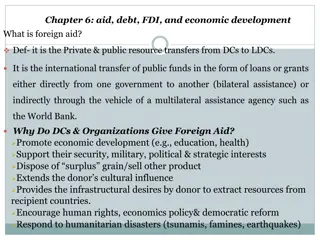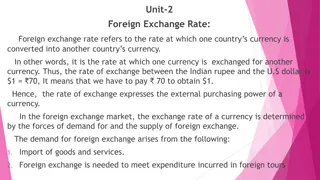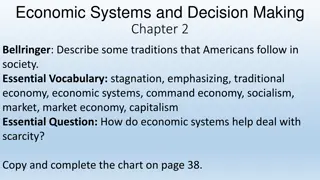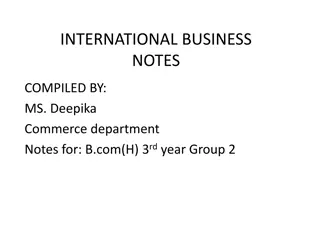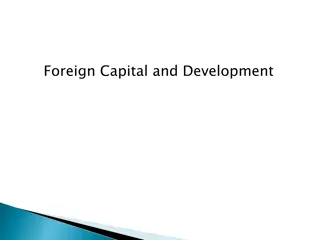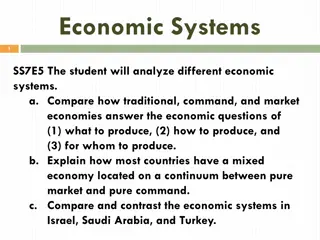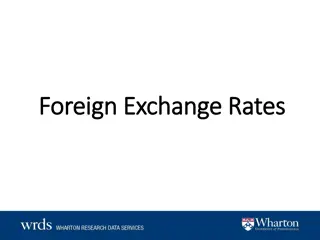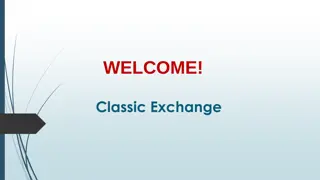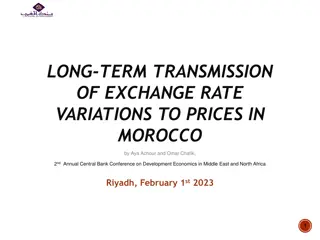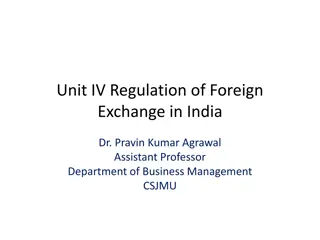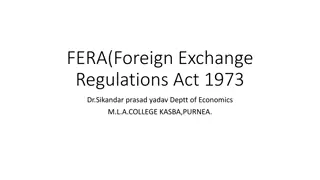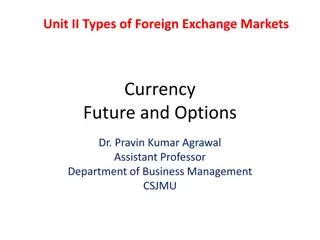Understanding Foreign Exchange Rate Systems and Their Impact on Economies
Foreign exchange plays a crucial role in the global economy, representing all currencies other than a country's domestic currency. Different exchange rate systems like fixed, flexible, and managed floating rates have distinct features and implications for trade, capital flows, and macroeconomic stability. Fixed exchange rate systems provide stability but require substantial foreign exchange reserves, while flexible systems allow market forces to determine exchange rates. Pegging involves tying a domestic currency's value to another currency. Understanding these systems' merits and demerits is essential for policymakers and businesses navigating the complexities of international finance.
Download Presentation

Please find below an Image/Link to download the presentation.
The content on the website is provided AS IS for your information and personal use only. It may not be sold, licensed, or shared on other websites without obtaining consent from the author. Download presentation by click this link. If you encounter any issues during the download, it is possible that the publisher has removed the file from their server.
E N D
Presentation Transcript
Foreign Exchange Rate & Balance of Payment 1 2 LECTURE LECTURE 3 4 LECTURE LECTURE
What is Foreign Exchange? Foreign Exchange refores to all currencies other than the domestic currency of a given country. For example, India s domestic currency is Indian rupee and all other currencies like US Dollar, British Pound, Kuwaiti Dinar etc. are foreign exchange.
Definition of Foreign Exchange Rate Foreign Currency Expressed in Domestic Currency $ = 40` Domestic currency expressed in terms of foreign currency 1 40 $=0.025$ 1 ` =
Types of foreign Exchange Rate Fixed Exchange Rate System Flexible Exchange Rate System Managed Floating Rate System [Exchange rate fixed by the monetary authority] [Exchange rate determined by market forces of demand and supply of foreign exchange] [Moderation of Exchange rate movements by the monetary authority]
Fixed Exchange Rate System Under a fixed exchange rate system, the determines the rate at which the domestic currency is exchanged with currencies. government foreign
Values of Currency is fixed in terms of Gold Standard Some external standard Gold Standard Bretton Woods Standard 1 =5gm of Gold 1$ = 2g of Gold Exchange Rate will be 1 = $2.5 Bretton Woods Standard Under this system each currency established an exchange rate in terms of US$ and gold. The US guaranteed the exchange of US$ into gold. ` 7 = $1 $35 = 1 ounce of Gold 1$ 7 1 1 ` 1 = ` 1= ounce of Gold 7 35 = 0.00408 ounce of gold
Pegging When the value of domestic currency is tied to the value of another currency, it is known as Pegging. yuan `
Merits of Fixed Exchange Rate System 1. Stability in the Exchange Rate 2. Promotes inflow of foreign Capital 3. Promotes international trade 4. Present speculative activities. 5. Coordination of Macro Economic Policies. De-merits of Fixed Exchange Rate System 1. Huge foreign exchange reserves required. 2. Difficulty in determining the exchange rate. 3. Difficulty in keeping the exchange rate fixed.
Determination of Exchange Rate Exchange Rate is determined by the interaction of the forces of demand and supply. To import Goods Tourism Unilateral Transfers sent abroad Purchase of asset in foreign countries Speculation
Demand Curve of Foreign Exchange Exchange Rate is determined by the interaction of the forces of demand and supply. $ Outflow of foreign Exchange
Import in ` Exchange Rate Import in $ $1=40` ` 80 2$ Rises $1=50 ` ` 100 Demand curve of Foreign Exchange 2$ (Price of Dollars in terms of Rs.) Rate of Foreign Exchange Y Imports become Expensive Demand for Imports / Foreign Exchange decreases D B E2 A E1 Thus, D When Exchange Rate Rises X O Demand For Foreign Exchange (in Dollars) Q2Q1 Demand for Foreign Exchange
Supply of Foreign Exchange $ Inflow of foreign Exchange
Export in ` Exchange Rate Export in $ $1=40 ` ` 100 $2.5 Rises $1=50 ` ` 100 $2.0 (Price of Dollars in terms of Rs.) Supply curve of Foreign Exchange Rate of Foreign Exchange Exports become Cheaper Demand for Exports / Foreign Exchange Increases. Y S B E2 Thus, A E1 When Exchange Rate Rises S X O Q2Q1 Supply for Foreign Exchange Supply of Foreign Exchange (in Dollars)
Equilibrium Exchange Rate Equilibrium is where? Determination of Exchange Rate Y Excess Supply Demand for Foreign Exchange (Price of Dollars in terms of Rs.) D S Rate of Foreign Exchange = E2 E E* Supply of Foreign Exchange E1 Excess Demand D S X Equilibrium Point = E* O Qs1 Qd2 Q Qd1 Qs2 Demand & Supply of Foreign Exchange (in Dollars) Equilibrium Exchange Rate = OE
Flexible Exchange Rate System It is the system in which the rate is determined by the forces of demand and supply in the foreign exchange market. Merits of Flexible Exchange Rate System 1. Maintains equilibrium level. 2. No need for huge foreign exchange reserves. 3. Optimum utilisation of resources. De-merits of Flexible Exchange Rate System 1. Instability in the exchange rate. 2. Encourages speculative activities. 3. Creates inflationary situation.
Managed floating Rate system It is the system in which foreign exchange rate is determined by market forces and central bank is a key participant in managing the exchange market. 47` / $ Wishes Fluctuations allowed 46.75 ` - 47.25 `
Managed floating Rate system Appreciation of ` Excess Demand for ` Exchange rate may fall from ` 46.75 / $ Central Bank will increase the supply of `. Depreciation of ` Excess Supply of ` Exchange rate may rise from ` 47.25 / $ Central Bank will demand rupees by exchanging $ for `.
Change in Exchange Rate Change in Supply Y (Price of Dollars in terms of Rs.) D Increase in Supply of Foreign Exchange S Rate of Foreign Exchange Excess Supply E* E Exchange rate falls E1 D S S1 X Depreciation of foreign currency O Q Q1 Demand & Supply of Foreign Exchange (in Dollars)
Decrease in Supply of Foreign Exchange Exchange rate rises Depreciation of domestic currency Change in Supply S2 Y Rate of Foreign Exchange (Price of $ in terms of Rs.) D S E2 S1 E E1 X O Q2 Q Q1 Demand and Supply of Foreign Exchange (in $)
Change in Demand Y Increase in Demand (Price of Dollars in terms of Rs.) D S Rate of Foreign Exchange E1 E*1 E* E Excess Demand Exchange Rate Rises D1 D S X O Q Q1 Appreciation of Foreign currency Demand & Supply of Foreign Exchange (in Dollars)
Change in Demand Decrease in Demand Appreciation of domestic currency Change in Demand D1 S Y Rate of Foreign Exchange (Price of $ in terms of Rs.) D E1 D2 E E2 X O Q2 Q Q1 Demand and Supply of Foreign Exchange (in $)
Kinds of Foreign Exchange Markets Spot Market Forward Market (Receipts and Payments are made immediately) (Sale and Purchase of Foreign Currency is Settled on a specified future date at an agreed rate)
Fore the Given Exchange rates state which currency is appreciating and which one is depreciating Old Exchange Rate New Exchange Rate Appreciating Currency Depreciating Currency 1 =1.5$ 1 =2$ $ 1 =3$ 1 =2$ $ 1HK$ =20 ` 1HK$ =18 ` HK$ ` 1US$ =100 1US$ =102 US$
Balance of Payments Balance of Payments is an accounting statement that provides a systematic record of all the economic transactions, between the residents of a country and the rest of the world, in a given period of time.
Economic Transactions 1. Visible Items X and M of goods (Iron, steel etc.) 2. Invisible Items X and M of Services (Insurance, Banking shipping etc.) 3. Unilateral Gifts (Remittances received and Sent, Gifts received and Sent Abroad 4. Borrowings from abroad Lending abroad or loan repayment 5. Sale of assets to foreigners Purchases of assets from foreigners
Economic Transactions contd Transactions that result in inflow of Foreign Exchange CreditItems Transactions that result in outflow of Foreign Exchange DebitItems SN. Credit Items Debit Items Export of goods 1 Import of goods Export of services 2 Import of services Unilateral transfers receipt 3 Unilateral transfers payments Borrowings from abroad 4 Lending abroad or loan repayment Sale of assets to foreigners 5 Purchases of assets from foreigners
State whether the following are DEBIT or CREDIT in India s BOP accounts Purchase of Italian clothes by Indian Residents. Purchase of a house by a Canadian in India. Sale of Indian Jewellery in the French market. Repayment of loan by government of India to the IMF. Sale of Shares of a foreign company by an Indian at the London Stock Exchange.
Balance of Trade Balance of Trade = Export of goods import of goods If Exports > Imports Balance of trade will be positive. If Imports > Exports Balance of trade will be negative.
Difference Between Balance of Trade & Balance of Payment SN Balance of Trade (BOT) Balance of Payments (BOP) Balance of trade includes only visible items. Balance of payments includes both visible and invisible items. 1 BOT does not record any transactions of capital nature. BOP records all the transactions of capital nature. 2 Balance of trade is a narrower concept and it is only a part of the balance of payments account. Balance of payments is a wider concept and it includes balance of trade. 3 Unfavourable balance of trade can be met out of favaurable balance of payments. Unfavourable balance of payments cannot be met out of favourable balance of trade. 4
Components of Balance of Payment Current Account Capital Account (Records all current international transactions for goods and services and unilateral transfers) (Records all international transactions which affect the assets and liabilities of the domestic country with the rest of the world)
Components of Current Account Visible Trade: Export and Import of goods like oranges, paper, bottles etc. The difference between exports and imports of goods is called balance on visible account or merchandise account. Invisible Trade: Export and Import of various services e.g. Banking, Airlines, insurance etc. Since services can t be seen, it is termed as invisible trade. The difference between export and import of invisible items is called balance on invisible account. Unilateral or unrequited transfers-unilateral transfers are payments and receipts that are made without any quid pro quo i.e. without any promise to supply any good or a service in return. In the Indian BOP account, unilateral transfer are a part of the invisible account. Balance on current account Balance on visible trade + = balance on invisible trade + Balance on unilateral transfers.
State whether the following are part of Visible trade account, Invisible account or Unilateral transfers in India s BOP accounts Sale of leather purses to China. Visible Trade Account Purchase of lamps from China. Visible Trade Account American staying at a hotel in India. Invisible Trade Account European company using Tata consultancy services. Invisible Trade Account Mr. Paul sending money from Kuwait to his valentines in Kerala. Unilateral transfers
Components of Capital Accounts 1. Private Transactions: Private sector of the country receives short-term and long-term foreign loans. Receipts of such loans are record as positive (credit) items and their repayment is recorded as a negative (debit) item. 2. Official undertaken by the government with the rest of the world. For example, government borrows loans from international organisation like IMF, World Bank etc. to finance the deficit in the balance of payments. Receipts of such loans are recorded on the positive (credit) side and repayment on the negative (debit) side. Transactions: It includes the transactions
Components of Capital Accounts Contd 3. Foreign Direct Investment: It refers to purchase of an asset in the rest of the world such that, it gives direct control to the purchaser over the asset. For example, acquisition of a foreign firm by an Indian firm. 4. Portfolio Investment: It refers to purchase of an asset in the rest of the world such that, it does not give the purchaser any direct control over the asset. For example, purchase of shares of a foreign firm by an Indian firm. Foreign Institutional Investment (FII) is also a part of portfolio investment. 5. Banking Capital: It refers to capital movements, in the form of foreign exchange transactions and investments in foreign currency and securities, by foreign branches of Indian commercial and cooperative bank (which are authorised to deal in foreign exchange). It also includes deposits of non- residents.
Balance on Capital Account The net value of credit and debit items arising out of capital transactions is the balance on capital account. The transactions, which lead to inflow of foreign exchange, are recorded on the credit side (Positive items). For example receipt of loan from abroad, sale of assets or shares in foreign countries etc. Similarly transactions, which lead to outflow of foreign exchange, are recorded on the debit side (Negative items). For example, repayment of loans purchase of assets or shares in foreign countries etc.
Difference Between Current Account and Capital Account SN Current Account Capital Account Current transactions change in the current level of a country s income account bring Capital transactions bring about a change in the capital stock of a country. 1 a It includes all items of flow nature and, so, it is a flow concept It includes all items expressing changes in stock and, hence, it is a stock concept. 2 Current Account = Visible Trade + Invisible Trade + Unilateral transfers Capital transactions transactions + Banking capital + Foreign direct Portfolio investment. account = Private Official 3 + investment +
Classify whether the following transactions are accounted for in the Current Account or Capital Account of India s BOP Sale of Indian Sarees in France. Current Account Purchase of RIL shares by a foreign resident. Capital Account Money received by Geeta from her husband in Dubai. Current Account Wipro borrowing from a European Bank. Capital Account Loan taken by the Government of India from World Bank. Capital Account
Autonomous and Accommodating Items Autonomous Non Autonomous/Accomodating items Accommodating items transactions that are undertaken in order to maintain the balance in the BOP account. Autonomous items refer to those international economic transactions which take place due to some economic motive (such as profit maximisation). refer to the Such transactions are independent of the state of BOP account. For example, if an MNC is making investment in India with the aim of earning profit, then such a transaction is independent of the country s BOP situation. These are compensating capital transactions which are meant disequilibrium in autonomous items of balance of payments. to correct the These items are also known as above the line items These items are also known as below the line items For example, if there is a current account deficit in the BOP, then this deficit is settled by capital inflow from abroad. Autonomous transactions take place on both, current and capital, accounts. On the current account merchandise export and imports of goods are autonomous transactions. On the capital account, receipts and repayments of long-term loans by private individuals are autonomous transactions. Generally, the sources used to meet a deficit in the BOP are accommodating items (i) Foreign exchange reserves; (ii) Borrowings from IMF or foreign monetary authorities.
Meaning of Balance of Payment Deficit A deficit in the BOP occurs when during the year the autonomous inflow of foreign exchange falls short of autonomos outflow.Autonomous payments > Autonomous receipts Suppose Autonomous receipts = $1000 Autonomous Payment = $1100 Deficit = $100 Two options to make and up for the deficit. 1. Borrowing from World Bank or IMF. 2. Depletion of foreign exchange Reserves (a) Foreign currency securities held with central banks Accomodating Items (b) Special Drawing Rights with IMF. (c) Gold Reserves
Table 1 : Major items of Indias Balance of Payments (U S $ million) April-June July-Sept October 2008-09 (PR) 2009-10 (PR) 2008-09 (PR) 2009-10 (PR) 2008-09 (PR) 2009-10 (P) 1. Exports 57,454 37,910 53,630 41,915 39,436 44,648 2. Imports 82,731 64,804 92,752 73,810 73,484 75,374 3. Trade Bal. (1.2) 25,277 26,894 39,121 31,895 34,049 30,726 4. Invisibles, net 22,003 20,534 26,546 19,955 22,381 18,696 5. Current A/c Balance (3+4) 3,274 6,360 12,575 11,940 11,668 12,030 6. Capital A/c Balance* 7. Change in Reserves# ( Indicates increase; + indicates decreases) 5,509 6,475 7,841 21,358 6,214 13,797 2,235 115 4,734 9,418 17,881 1,767
*: Including errors and omissions. #: Ib BoP basis (i.e., excluding) P : Preliminary. PR : Partially Revised. (Source www.rbi.org)
Balance of Payment Account Always Balances Autonomous receipts < ( ve entry on Debit side) If deficit in BOP Autonomous Payment Central Bank will deplete its foreign exchange reserves it will either sell foreign securities or sell SDR s which will result in inflow of foreign exchange (+ ve entry on Credit side) BOP therefore balances If surplus in BOP Autonomous receipts > Autonomous Payment (+ ve entry on Credit side) Central Bank will accumulate foreign exchange reserves i.e. it will purchase foreign securities or SDR s which will result in outflow of foreign exchange. ( ve entry on Debit side) Thus, BOP always balances.
Cause of disequilibrium in BOP Economic Factors (i) Imbalance between exports and imports. (It is main cause of disequilibrium in BOP). (ii) Large scale development expenditure which cause large imports (iii) High domestic prices which lead to imports (iv) Cyclical fluctuations (like recession or depression) in general business activity. (v) New sources of supply and new substitutes.
Cause of disequilibrium in BOP contd.. Political Factors: Experience shows that political instability and disturbances causes large capital outflows and hinder inflows of foreign capital. Social Factors: (i) Changes in fashions, tastes and preferences of the people bring disequilibrium in BOP by influencing imports and exports. (ii) High population growth in poor countries adversely affect their BOP because it increases the needs of the countries for imports and decrease their capacity to export.
Cause of disequilibrium in BOP contd.. Measures to correct disequilibrium in BOP (i) Export promotion: Exports should be encouraged by granting various bounties to manufacturers and exporters. A the same time, imports should be discouraged by undertaking import substitution and imposing reasonable tariffs. (ii) Devaluation of domestic currency: It means fall in the external (exchange) value of domestic currency in terms of a unit of foreign exchange which makes domestic goods cheaper for the foreigners. Devaluation is done by a government order when a country has adopted a fixed exchange rate system. Care should be taken that devaluation should not cause rise in internal price level. (iii) Exchange control: Government should control foreign exchange by ordering all exporters to surrender their foreign exchange to the Central Bank and then ration out among licensed importers.
Cause of disequilibrium in BOP contd.. (iv) Depreciation: Like devaluation, depreciation leads to fall in external purchasing power of home currency. Depreciation occurs in a free market system wherein demand for foreign exchange far exceeds the supply of foreign exchange in foreign exchange market of a country. (Mind, devaluation is done in fixed exchange rate system). (v) Reducing inflation: Inflation (continuous rise in prices) discourages exports and encourages imports. Therefore, government should check inflation and lower the prices in the country.) (vi) Import Restrictions and Import Substitution are other measures of correcting disequilibrium.



